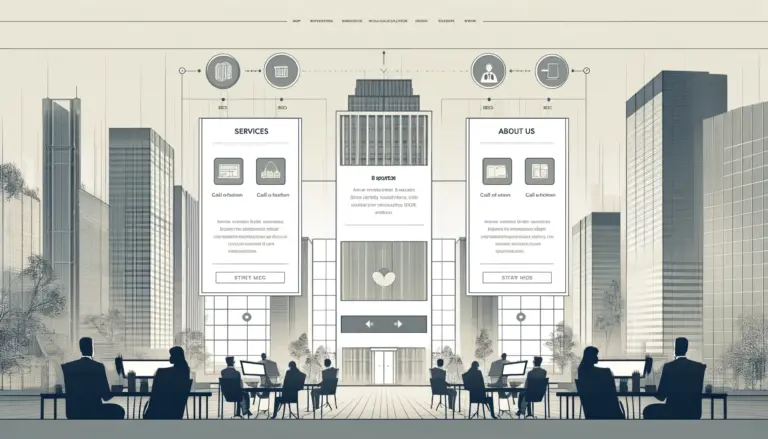Imagine you have a successful business. Everything is running smoothly, but suddenly the market changes and your competitors introduce new technologies. What do you do now? This is where the importance of continuous development in the B2B world comes in.
Imagine you are a tough knight in a world full of dragons. Your armor must always be in top condition, right? Otherwise, you can’t fight the dragons. That’s how it works in business, especially in B2B, or Business-to-Business. Here, companies must constantly adapt and improve to stay one step ahead of the competition.
Brief Listing of Crucial Features
- Strategic Thinking Ability: Like a master chess player, you must always think a few steps ahead.
- Technological Skills: This is your secret weapon to work faster, smarter and more efficiently.
- Creative Leading: A good dose of creativity can set you apart from the rest.
- Innovative Content Strategy: Good content is like a magnet that attracts customers.
- Data-driven Decision Making: Let the numbers speak for you and make smarter decisions.
- Curious, Continuous Learner: Always staying curious and learning new things.
- Collaborative: Teamwork makes everything better, even dreams come true.
- Strategic and Communicative LeadershipKnowing where you want to go and taking others with you.
- Focused on Diversity, Equality and Inclusion: A diverse workplace is a source of innovation and happiness.
In the coming sections, we’ll take a closer look at each of these traits and show how they contribute to your success in the B2B world. So, let’s start the adventure!
Strategic Thinking Ability
Strategic thinking may sound difficult, but it is actually quite simple. It means thinking ahead and planning for the future. Think of a chess master thinking several moves ahead to outsmart his opponent. In the B2B world, this is just as important. Companies need to know where they want to go and how to get there. Without strategic thinking, they would be like a ship without a compass, floating around without a goal.
Imagine you own a candy store and you notice that chocolate is very popular right now. Strategic thinking would mean purchasing more chocolate products and perhaps even introducing new flavors. In B2B marketing, for example, this could mean adapting your marketing campaigns based on the latest trends and technologies. A good example is a company that uses data analytics to find out what their customers want, and tailors their products and services accordingly.
Benefits of Strategic Thinking Skills
Enhanced Decision Making
Strategic thinking allows you to make better decisions. It’s like having a map in a maze. Instead of trying every turn and hoping to find the right one, you can plan ahead and find the fastest way to the exit. This helps companies work more efficiently and make fewer mistakes.
Long-term Vision
Strategic thinking skills also help you have a long-term vision. Instead of focusing only on what is important today, look at where you want to be in five or 10 years. This helps companies grow sustainably and prepare for future challenges. It is like a gardener who not only waters his plants today, but also plants for the next season.
Tips for Developing Strategic Thinking Skills.
Continuous Learning
Continuous learning is one of the best ways to develop your strategic thinking skills. Just as a good knight is always learning new combat techniques, B2B professionals should always be on the lookout for new knowledge and skills. This can be done by taking courses, reading books and articles, or even by learning from colleagues.
Mentorship
A mentor can be invaluable. This is someone with a lot of experience who can guide and advise you. It is like a wise old wizard who helps the young hero find his way. By learning from the experiences and insights of a mentor, you can improve your own strategic thinking skills and grow faster in your career.
Technological Skills
Technology skills, or tech skills, may sound like something for nerds in labs, but they are super important for anyone in the B2B world! They include everything you need to do well with technology, such as using software, data analysis, and even a little coding. In the B2B world, these skills help companies work faster, smarter, and better. Without technology skills, a company would be like a knight without a sword – ready for battle, but without the right tools.
Let’s look at how technology is used in the real world. Imagine you have a cake store and you want to know which cake is the most popular. With technology skills, you can use a software to analyze sales data and see that chocolate cakes sell best. In B2B marketing, companies do something similar: they use data analysis to understand what their customers want and adjust their strategies accordingly. An example is a company that uses social media tools to advertise their products and communicate with their customers.
Benefits of Technological Skills
Increased Efficiency
Technology makes everything faster and easier. Imagine having to do homework without a computer – it would take much longer! In the B2B world, technology helps companies work faster and more efficiently. With the right software, they can automate tasks, which means less time spent on boring chores and more time for important things like coming up with new ideas.
Competitive Edge
Technology can also give companies an edge over their competitors. Think of it as a secret superpower. If your company uses the latest technology and the competition does not, you can work faster and better. This can mean your business gets more customers and is more successful. It’s a bit like a race car with a turbocharger – you just go faster than everyone else.
Tips for Improving Technological Skills.
Training Programs
One of the best ways to improve your technology skills is to attend training programs. These are courses that teach you all about new technologies and how to use them. Think of taking an online course on how to build a Web site or how to analyze data. It’s like going to school, but for cool technology stuff.
Hands-on Practice
Practice makes perfect, and the same goes for technology skills. By just doing, you learn best. This means getting started with new software or tools yourself. For example, try building a simple Web site or playing with a data analysis program. Just as you get better at soccer by training on the field, you get better at technology by putting it into practice.
Creative Leading
Creativity is not just for artists and writers; it is also very important in business, especially in B2B (business-to-business). But what does creativity really mean? It is about coming up with new and original ideas that stand out. In the B2B world, creativity can help companies stand out from the competition and reach customers in interesting ways.
Let’s look at real examples. Consider a company that makes a super cool video to promote their products, or launches a funny social media campaign that goes viral. For example, a software company created a humorous animation to explain their services. These types of creative campaigns grab attention and make the company brand memorable.
Benefits of Creative Leading
Brand Differentiation
One of the biggest advantages of being creative is that it helps you stand out. Imagine you are at a party where everyone is wearing the same boring gray sweater, and you come in in a bright yellow sweater with a funny text on it. Everyone will notice you immediately! That’s what creativity can do for a brand – it helps you stand out from the rest and stand out in the crowd.
Customer Engagement
Creativity can also help make customers more engaged. A boring ad you quickly skip over, but a funny or interesting ad? You’ll keep watching those! By being creative, you can grab customers’ attention and get them excited about your products or services. This often leads to more interaction and ultimately more sales.
Tips for Creative Leading
Brainstorming Sessions
A good way to stay creative is to brainstorm regularly. This means getting together with your team to spout ideas, no matter how crazy they are. No idea is too weird during a brainstorming session! You might think of ways to promote your products in a fun way, such as funny videos or interesting blog posts.
Creative Workshops
In addition, creative workshops are super helpful. These are courses where you learn how to think and work more creatively. It’s like art class, but for adults! You learn new techniques and methods that you can apply in your work. So if you find yourself stuck in your old habits, try taking a creative workshop to get new inspiration.
Innovative Content Strategy
An innovative content strategy is a smart way businesses create and share interesting and unique content to attract and engage other businesses. This goes beyond just writing some blogs or posting something on social media every now and then. It is a well thought out plan that helps build a strong brand, engage customers and ultimately generate more sales.
Let’s look at some examples. Imagine a company creating a series of funny and educational videos about their product. Or consider an interactive quiz on their website that helps visitors choose the right service. Another example is a company offering an eBook full of useful tips in exchange for the visitor’s email address. These clever strategies help companies stand out and engage their audience in a fun way.
Benefits of Innovative Content Strategy
Audience Connection
One of the biggest benefits of an innovative content strategy is that it helps create a stronger connection with your audience. Imagine reading a blog post that precisely addresses a problem you have. You feel understood and are more inclined to read more of that content. This creates a deeper connection and loyalty from your audience.
Content Performance
Another important benefit is that the performance of your content improves. With an innovative approach, you can ensure that your content is shared more often, gets more comments and ranks better in search engines. This means more visitors to your website and ultimately more customers for your business.
Tips for Innovative Content Strategy
Trend Analysis
A good tip is to always be aware of the latest trends. This means researching what is popular in your industry and using this to improve your own content. For example, if you see that short videos are doing well, you can create more of them for your audience.
Audience Feedback
Gathering feedback from your audience is also super important. Ask your audience what they think of your content and what they would like to see more of. You can do this through surveys, polls on social media, or simply asking for comments under your blog posts. With this feedback, you can tailor your content even better to what your audience wants.
Data-driven Decision Making
Data-driven decision-making is a smart way of making decisions in which companies collect and analyze data to make better choices. Instead of relying solely on gut feeling or experience, they use numbers and facts to determine the best move. This helps companies be more accurate and effective in their strategies and execution.
Imagine a company using data to see which products are most popular with their customers. They can then make more of these products and less of the ones that don’t sell as well. Or imagine a marketing team analyzing data to understand which advertising campaigns work best. These insights allow them to spend their budget better and attract more customers.
Benefits of Data-Driven Decision Making
Accuracy
One of the biggest benefits of data-driven decision-making is accuracy. When companies make decisions based on data, they can see exactly what works and what doesn’t. This means their strategies and plans are much more effective. Think of a soccer team watching video recordings of their games to see where they can play better. Similarly, companies can improve their performance by looking at data.
Predictive Insights
Another big advantage is predictive insights. With the right data, companies can predict what will happen in the future. For example, a toy store can use data to predict which toys will be most popular around Christmas. This allows them to be better prepared and have enough stock to meet demand.
Tips for Data-Driven Decision Making
Data Literacy
It is important that everyone in the company understands how to read and use data. We call this data analysis skills. Just as you need to learn how to read and write, you also need to learn how to analyze data. Companies can offer training courses and workshops to train their employees in this. This way, everyone becomes a bit of a data expert!
Tool Utilization
There are many tools and software programs that can help companies analyze data. Consider programs such as Excel, Google Analytics or special data analysis tools. By using these tools, companies can easily and quickly find and analyze the right data. This makes the whole process of data-driven decision-making a lot easier and more efficient.
Curious, Continuous Learner
Continuing education is like a superpower that helps you always get smarter and better. It means you are always learning new things, whether you are in school or already working. For example, if you are a chef, you always want to learn new recipes and cooking techniques. This not only helps you become a better cook, but also helps keep your restaurant popular.
Imagine working in a toy factory. By constantly learning, you can discover how to make toys that are even more fun and safe. Or imagine being a doctor who always stays up to date on the latest medical techniques and medicines. This allows patients to get better faster. Continuous learning means you are always looking for ways to do your job better and smarter.
Benefits of Continuous Learning
Skill Enhancement
A great advantage of continuous learning is that you can constantly improve your skills. It’s like a video game: the more you play, the better you get. For example, if you are a graphic designer, you can learn to use new software to create even more beautiful designs. This not only makes your work more fun, but also more valuable.
Adaptability
Another advantage is adaptability. In today’s world, things change at lightning speed. Just think about how quickly new technologies and trends emerge. Constant learning allows you to adapt to these changes. For example, if you work in marketing, you must always be up to date with the latest social media trends to properly promote your business.
Tips for Continuous Learning
Online Courses
A great way to constantly learn is to take online courses. There are many websites where you can take courses on almost any subject you can think of. Whether you want to learn programming, learn a new language or know how to start a business, there is always an online course that can help you.
Professional Networks
Networking with professionals is also an excellent way to learn. This means you connect with people who do the same work as you, but may have more experience. You can exchange ideas, ask questions and learn from their experiences. It’s like a group of friends, but for work!
Collaborative
Being collaborative means being able to work well with others. In the B2B (Business-to-Business) world, where companies do business with other companies, this is super important. Teamwork allows everyone to contribute their unique talents and ideas to achieve something great together. It’s like a soccer team: you don’t just need a striker, you need defenders, midfielders and a goalkeeper to win.
A good example of collaboration in the B2B world is when a software company collaborates with a marketing company. The software company develops a new product, and the marketing company helps to market it. By working together, they can accomplish much more than if they did it alone. Or consider a construction project in which architects, engineers and contractors work closely together to create a building. Each brings their own expertise, leading to a successful project.
Benefits of Collaborative Focus
Team Synergy
Synergy is a difficult word that actually means that you can accomplish more together than alone. Imagine making a big puzzle with your friends. Alone it would take you days, but together you can do it much faster and more fun. In a business, it means that by working well together, you can get better results. For example, if the sales and customer service departments work well together, together they can satisfy and retain more customers.
Shared Goals
Having common goals ensures that everyone is in the same boat and rowing toward the same goal. This motivates people to work hard and help each other. Imagine doing a competition with your class to have the cleanest class in the school. If everyone does their job well, together you win the prize. In a company, this means that if everyone works toward the same goal, such as launching a new product, the company will be more successful.
Tips for Collaborative Focus
Team-building Activities
Team-building activities are a great way to improve cooperation. These can be anything from a field day to an escape room. The idea is that you work together on a fun challenge, which strengthens bonds and improves communication. Just think about how fun it is to do a scavenger hunt with your friends. You get to know each other better and work together to solve the tasks.
Open Communication
Open communication means talking to each other honestly and clearly. This is essential for good cooperation. For example, if you are doing a group project at school, it is important that everyone knows what is expected of them and that you help each other when needed. In a company, this means talking to your team regularly, sharing ideas and giving each other feedback. As a result, you avoid misunderstandings and work together more efficiently.
Strategic and Communicative Leadership
Strategic and communication leadership are important skills for anyone leading in the business-to-business (B2B) world. Strategic leadership means having a plan for the future and knowing how to lead your team to success. Communicative leadership means that you are good at talking and listening so that everyone understands what needs to be done. It’s like being the captain of a ship: you have to know where you’re going and make sure your crew can follow you.
A good example of effective leadership is Satya Nadella, the CEO of Microsoft. When he took office, he gave a clear direction to the company by focusing on cloud computing. He clearly communicated this vision to his team, which led to great results. Another example is Elon Musk, who motivates his teams at SpaceX and Tesla by sharing his vision for a sustainable future and space exploration.
Benefits of Strategic and Communicative Leadership
Clear Direction
When a leader provides clear direction, everyone knows what needs to be done and what their role is. This prevents confusion and ensures that everyone is on the same page. Imagine doing a scavenger hunt with your group of friends. If the leader of the group gives a clear map and instructions, everyone knows where to go and what to do.
Motivation
A good leader motivates his team by involving them in plans and encouraging them. This makes team members feel valued and more committed to their work. It is like a soccer coach encouraging his team and showing them how important their contribution is to winning the game.
Tips for Strategic and Communicative Leadership
Leadership Training
Taking leadership training can help you become a better leader. These trainings teach you how to think strategically and communicate effectively. It’s like continuing education in school: the more you learn, the better you become. For example, companies like Google offer leadership training for their employees to help them grow and perform better.
Feedback Culture
Creating a culture where giving and receiving feedback is normal helps everyone grow. This means not being afraid to speak your mind and being open to suggestions from others. It’s like in school, where your teacher helps you improve by correcting your work and giving tips. In a company, this can mean having regular team meetings where everyone can give feedback on each other’s work.
Focused on Diversity, Equality and Inclusion
Diversity, equity and inclusion (DEI) are three important concepts often used together. Diversity means having different types of people with different backgrounds, experiences and perspectives. Equality means giving everyone the same opportunities, no matter who they are. Inclusion means that everyone feels welcome and valued. In the B2B world, where companies do business with other companies, DEI is very important because it helps create an environment where everyone can work together and feel comfortable.
There are many examples of companies that are successful because of their focus on DEI. Take Microsoft, for example, which is actively promoting diversity and inclusion within their teams. This has led to innovative products and a positive work culture. Another example is Salesforce, which is known for its inclusive workplace and equality initiatives. These companies show that DEI is not only good for society, but also for business.
Benefits of Diversity, Equality and Inclusion
Innovation
One of the greatest benefits of diversity is innovation. When people with different backgrounds and perspectives work together, new ideas and solutions emerge. It’s like a potluck dinner where everyone brings a different dish; you get a much more varied and interesting menu than if everyone had brought the same dish. Diverse teams can tackle problems in creative ways and often come up with unique solutions that others might not have thought of.
Employee Satisfaction
An inclusive workplace where everyone feels valued leads to satisfied and engaged employees. People want to work in an environment where they are respected and where their opinions count. This makes employees stay with the company longer and more committed to their work. It’s like a sports team: when everyone feels valued and supported, the team plays better and everyone stays motivated.
Tips for Diversity, Equality and Inclusion.
Inclusive Policies
Developing inclusive policies is an important step in promoting DEI. This can mean ensuring that there is no discrimination in hiring new employees, that there are equal opportunities for promotion, and that everyone has access to the same resources and support. Companies like IBM have implemented inclusive policies to ensure that everyone has equal opportunities and feels welcome.
Awareness Programs
Awareness and education programs can help make everyone in the company aware of the importance of DEI. This can include trainings on unconscious bias, workshops on cultural sensitivity and lectures by various speakers. For example, Google regularly organizes awareness programs to educate their employees about diversity and inclusion, which helps create a more inclusive work culture.
By focusing on diversity, equality and inclusion, B2B companies can not only have a positive impact on society, but also increase their own success. Diverse teams bring innovative ideas, and inclusive workplaces ensure satisfied and engaged employees. That’s a win-win for everyone!
Conclusion
In the dynamic and rapidly changing B2B world, continuous development is not a luxury but a necessity. It requires strategic thinking, technological skills, and a hefty dose of creativity. Having an innovative content strategy and data-driven decision-making also play a crucial role. By always staying eager to learn, being collaborative, and focusing on diversity, equity, and inclusion, B2B professionals can not only keep up, but be ahead.
Together, these attributes form a strong foundation for success. They help companies remain resilient and flexible in a competitive marketplace. So, whether you run a start-up or a large company, continuing to evolve and adapt is the key to sustainable success. Stay curious, keep learning, and keep improving – then you’ll be ready for any challenge the future brings!






